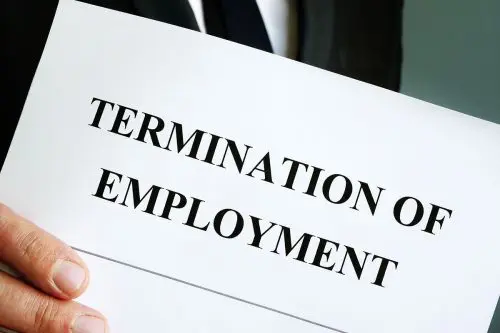Ever feel a little lost navigating the maze of employee dismissals? You’re not alone. Spotting signs of unfair dismissal can be tricky, yet it’s crucial for maintaining integrity and morale in any workplace.
Knowing what to watch out for helps you safeguard against wrongful termination claims. From lack of documentation to hints of discrimination, there are clear indicators every HR pro should recognize.
Curious about those red flags and how to address them effectively? Read on to keep your team on solid ground.
1. Lack of Proper Documentation
Firing someone isn’t just about making the call. Terminating an employee should come with a clear paper trail, capturing all steps leading up to the decision. Incomplete documentation often hints at hurried or unfair dismissal practices. It includes records like performance reviews and disciplinary actions.
Documentation also serves as a critical defense in legal situations, offering transparency and justification for the employer’s choice. Establishing consistent record-keeping ensures decisions hold water and withstand scrutiny from internal reviews or potential legal proceedings down the line.
2. Recognizing Discrimination Signs in Dismissals
Nothing is more tormenting than losing your job just because you’re female, younger, of a different race, or perhaps disabled. When dismissal decisions align too closely with personal attributes rather than performance metrics, discrimination could be at play.
Unfair treatment rooted in bias doesn’t just affect the individual. It poisons workplace culture and reputation. Experts point to discrimination as among the popular examples of wrongful termination cited by legal professionals.
Proactive vigilance and inclusive policies can protect against such injustices and promote fairness within organizational practices for all employees.
3. Due Process Omissions
Needless to reiterate, you don’t just wake up one morning as the boss and decide to fire someone. It’s against the law. Fair termination from employment requires following established procedures and offering employees a chance to respond or improve.
Skipping steps like performance improvement plans or failing to document meetings with employees suggests due process omissions. These gaps weaken an employer’s position if challenged legally, making it crucial for HR professionals to ensure all proper protocols are followed before finalizing any dismissal decision.
4. Understanding Company Policy Inconsistencies
Imagine playing a game where the rules change halfway through—frustrating, right? Inconsistent application of company policies can create similar chaos when managing employee dismissals. These discrepancies often suggest potential unfairness in termination decisions.
Considerations include:
- Application of disciplinary actions
- Evaluation metrics for performance reviews
- Transparency in communication channels
Such variations not only impact team morale but also raise legal red flags regarding discrimination or bias claims. Ensuring consistency on how to terminate an employee protects the organization and maintains trust within the workforce. It does so by upholding transparent and fair practices throughout all HR processes.
5. Investigating Retaliation for Whistleblowing
Could the employee have been dismissed for reporting an illegal act, misconduct, or perhaps a safety violation? Retaliatory dismissals often hide behind weak justifications, undermining ethical business practices.
Whistleblowers play a crucial role in maintaining accountability within organizations. Firing them not only damages trust but also exposes the company to legal challenges.
Careful assessment of dismissal circumstances ensures decisions aren’t tainted by retaliation motives. Protecting these individuals is essential for fostering an environment where employees feel safe and encouraged to speak out against wrongdoing.
6. Absence of Performance Issues
If an employee consistently fails to achieve or meet a certain threshold, their dismissal could be justified. However, firing someone without concrete evidence of poor performance raises questions about fairness.
Terminations lacking clear ties to documented shortcomings often indicate underlying issues like personal bias or discrimination. Detailed evaluations and constructive feedback are key for ensuring dismissals align with genuine work-related concerns.
Transparent appraisal processes help protect the company from wrongful termination claims. They also reinforce equitable treatment within teams, fostering trust and motivating employees to improve where necessary.
7. Lack of Progressive Warnings
In the workplace, some doings or misdoings are punishable through a series of escalating responses before termination becomes an option. Employers typically implement stages of disciplinary action to give employees opportunities for correction.
These often include:
- Verbal warning
- Written warning
- Suspension
- Termination
Firing without prior warnings overlooks this process, signaling potential unfairness. Employees deserve clarity on their standing and a chance to rectify issues.
Ensuring progressive discipline is documented reinforces fairness in dismissal decisions and protects organizations from legal repercussions by demonstrating a clear effort to address performance or behavioral problems.
8. Detecting Coerced Resignations
Imagine feeling cornered to resign rather than being directly fired. Such coerced resignations often indicate unfair dismissal practices that pressure employees out of their roles.
Look for signs like sudden changes in work conditions, isolation from colleagues, or relentless criticism without justification. These tactics may compel someone to quit.
Identifying these red flags is essential for HR professionals aiming to uphold fairness and legal integrity in termination processes. Offering support channels helps ensure employees feel safe reporting coercion attempts without fear of retaliation.
9. Unaddressed Grievances in Terminations
Sometimes dismissal stems from past conflicts between employees and management, lingering unresolved until they surface as reasons for termination. When these underlying issues aren’t addressed, terminations may appear unjust.
Spotting this involves scrutinizing any ongoing disputes or complaints that were ignored before the decision to fire was made. Following a thorough grievance procedure can illuminate such issues.
Transparent processes ensure grievances are acknowledged and resolved, preventing unfair dismissals rooted in overlooked problems or interpersonal friction within the workplace.
The Impact of Unfair Dismissal on Company Culture
An unfair dismissal echoes beyond legal challenges, eroding trust and morale within teams. It fosters an environment where employees feel undervalued or insecure, hindering productivity and growth. Proactive fair practices ensure a positive workplace atmosphere persists.
For HR professionals, spotting these signs ensures fairness and integrity, ultimately protecting both the workforce and company reputation.





